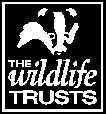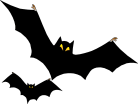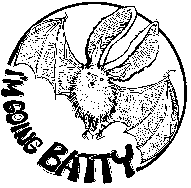ADOPT-A-BAT CHRISTMAS NEWSLETTER
 | Welcome
to our Christmas edition of Adopt-a-Bat. It’s been a busy year here at the
hospital, with a lot of new bats coming and going and lots of new helpers too! Thanks
for all the help and support you have given us over the past year. Without people
like yourselves we really wouldn’t be able to keep going. We hope you enjoy
the Christmas edition of Adopt-a-Bat and have a brilliant Christmas and New year The
hospital has really gone international now, with the Cornwall Wildlife Trust launching
its web site last July. We have people adopting bats from Europe already, so now
perhaps we can attract people from other parts of the world too? |
A word from Ginni
| Some
of you may have heard about my unfortunate accident back in July? I tripped over
while out shopping and broke my ankle! This resulted in surgery and having to
be hospitalised for eight weeks. Because I was unable to get around on my own
I had to spend some time convalescing at the Homeward Bound Unit at St Martin’s
Residential Home. I would like to say a special thank you to all the staff
at the hospitals and hope our bats are looked after as well as I was. Also, what
would I have done without our New Deal staff, especially Toby who took charge,
Aaron and Eleanor, who sat up night after night feeding baby bats, and John Page
from the Bat Group who was always on hand to give expert advice? It was a busy
time with a total of 82 bats arriving of which 18 were tiny babies, requiring
a feed every two hours! Since the last newsletter in July we have released 32.
Some are still recovering but we may release more in the new year. |  |
I'd just like to end by thanking everyone involved with the hospital,
and wish everyone a very happy and peacefull Christmas.
Ginni
 | If
you didn’t already realise, the Bat Hospital is
part of the Cornwall Wildlife Trust. The Trust fulfils a role occupied by no other
countryside organisation, being concerned solely with Cornwall and dealing with
all aspects of conserving the county’s wildlife and habitats. The Trust
already has over 40 nature reserves, in which a variety of Cornwall’s habitats
are home to nationally rare and endangered species. A good example of this is
the greater horsehoe bat living in Prideaux Woods, one of our more recent acqusitions. |
|
A large part of both the Bat
Hospital and the Trust’s work is to promote awareness among both adults
and the younger generation. As well as providing a range of educational services,
there are two junior clubs – Fox Club and Cornwall Wildlife Watch. Give Tricia
a call on (01872) 273939 for more details.
| Thank you for any stamps sent in. We’ve had a great
response. Some are now on sale at the Trust’s Shop in Penzance and are raising
much-needed funds for us. Please keep collecting and sending them
in. Cornwall Wildlife Trust, Five Acres, Allet, Truro, Cornwall
TR4 9DJ |
SPECIES WE SEE OFTEN AT THE HOSPITAL
Pipistrelle
The
pipistrelle is the smallest and most common bat in Britain. It would fit snugly
into a matchbox and weighs less than a two pence piece. Over 90% of bats brought
in are young pips.
Brown long-eared
The brown long-eared
bat is the second-most common bat in Britain. A medium-sized bat with broad wings,
it has a slow flight - almost hovering at times.Often referred to as the "whispering"
bat, the brown long-eared bat calls very quietly, picking up the faint echoes
with its big ears.
Whiskered
As its name suggests,
this bat’s lips have long sensory hairs. It usually haunts woodlands, particularly
those with stretches of water such as a river or pond. In flight it can be difficult
to distinguish a whiskered bat from a pipistrelle, but whiskered tend not to fly
so fast and seem more steady. We are less likely to be able to hear their calls
as we can a pipistrelle, as we have difficulty picking up on their frequency.
Natterer’s
The
Natterer’s bat has a pinkish face and a wing span up to 12" (30cm).
It is much bigger than the pipistrelle. The fur on its back is grey-brown but
its underparts are creamy-white. This type of bat loves both woodlands and pastures.
BAT FACTS
| Bats are
extremely useful. They help to control the insect population, re-seed cut forests
and pollinate plants that provide food for humans. Bacteria in their guano are
useful in improving soaps, making gasohol and producing antibiotics, besides making
a fertiliser. |  |
Some vampire bats have been known to adopt orphans and will even risk
their lives to share food with less fortunate bats just because they share a roost.
Most animals who share food only do so with their relatives.
Scientists
have now decided there are two distinct types of pipistrelle, the brown-faced
and the bandit?
FURRY’S SISTER?
On 28th August, a little
female bat was brought in to us. She had been mauled by a moggy! It turned out
that it was the same puss that caught our Furry and she was from the same roost.
Now it’s a bit far fetched to think that she is actually Furry’s sister
but she could well be a very close relation. Ginni called her Gertiebanksia all
the same. She has recovered now and has been released back. Unfortunately there’s
not much we can do about the moggy though. Once a cat has found a roost, it often
spends time there just waiting for the little ones to emerge. So watch out Gertiebanksia!
What’s in a name?
| When I first went to
the Bat Hospital one of the first things that struck me was the peculiar names
of some of the bats. After working with Ginni for over a year now I’ve got
to know some of the bats very well and can understand why some of them have come
out. Every bat that arrives at the hospital is given a name. Here’s just
a few examples of how they got them. |
| Apple
Blossom | - | She
was found on a farm in an apple orchard. |
| Charlie | - | Casper,
the person who rescued him, wanted the bat named after his pet dog. |
| Elver | - | Elver
came to us as a youngster from Eel Pie Island in the Thames (when Ginni was working
in London) and the Thames is full of elvers which are young eels. |
| Gryphon | - | A
variation of the name Griffiths as he was rescued by Mr Griffiths. |
| Halloween | - | Arrived
one Halloween and it seemed appropriate. |
| Eamon | - | Named
after his rescuers favourite TV presenter Eamon Andrews! |
| Furrybanksia | - | A
very imaginitive one this. Furrybanksia was bought in by a Mr Banks. This prompted
Ginni to recall a gentleman called Joseph Banks who on one of Captain Cook’s
voyages to Australia named a group of plants "banksias". Ginni originally
thought he was a girl so added fairy, as in folklore fairies spend a lot of their
time hanging about on banks. But once she realised he was a boy she thought furry
was more suitable. Phew! |
| Gertiebanksia | - | She
was from the same roost as Furrybanksia but arrived from the vet in a box with
a lable marked "Gertie" which was orginally for a dog. |
The Cornwall Bat Group
 | As
well as the Cornwall Bat Hospital in Penzance there
is a very active Bat Group which covers the whole county. The group has a number
of licensed bat workers - people who are passionate about bats and volunteer to
help and promote our bats plight. The volunteers are often called upon
to visit buildings to look for evidence of roosts. As I expect you are aware,
bats are protected by law and so are their homes. The Bat Group helps by advising
on how people can live harmoniously with bats. Members advise on important things
like suitable timber treatments for buildings that don’t hurt the bats. To
find out more about the Bat Group, contact John Page, 3 Belgravia Place, Sheffield,
Penzance, Cornwall, TR19 6UJ. Tel: (01736) 732037 |
It’s
just not cricket!
During the summer we received a telephone call from a
distressed Mrs Ball. Her family had been relaxing and playing a friendly game
of cricket that evening, when the batter suddenly struck something in the air
with the ball! That thing fell to the ground and turned out to be a very stunned
little bat!
Cricket, as he was christened, was brought in to the hospital
by the Ball family straight away, where he was given a thorough check-up, some
yummy mealworms and time to recuperate before he returned to watch the cricket
from a safe distance.
This scenario is surprisingly common. WG Grace was
even know to have caught a swallow while he was fielding in a cricket match, mistaking
the little animal for a cricket ball!
BATTY WORD SEARCH
| E | L | L | E | R | T | S | I | P | I | P |
| U | L | T | R | A | S | O | U | N | D | H |
| M | E | A | L | W | O | R | M | S | L | U |
| R | I | N | S | E | C | T | S | Y | L | E |
| O | L | T | Y | E | L | D | T | W | Y | P |
| C | A | L | K | R | T | U | W | I | N | G |
| C | T | O | M | U | G | S | T | P | O | S |
| E | A | S | T | N | J | K | P | C | L | A |
| T | N | A | T | T | T | E | R | S | O | I |
| Z | B | R | I | A | S | R | T | O | C | N |
| This puzzle contains words associated
with our bats. Some words are forwards, some are backwards and some are horizontally
across the page! See if you can find them. - BAT
- COLONY
- DUSK
- INSECTS
- MEALWORMS
- NATALIE
- NATTERERS
- NOCTULE
- PIPISTRELLE
- ULTRASOUND
- WING
|
Reproduced with the kind approval
of The Cornwall Wildlife Trust
Cornwall Connect Wild
Cornwall Countryside
& Arts




